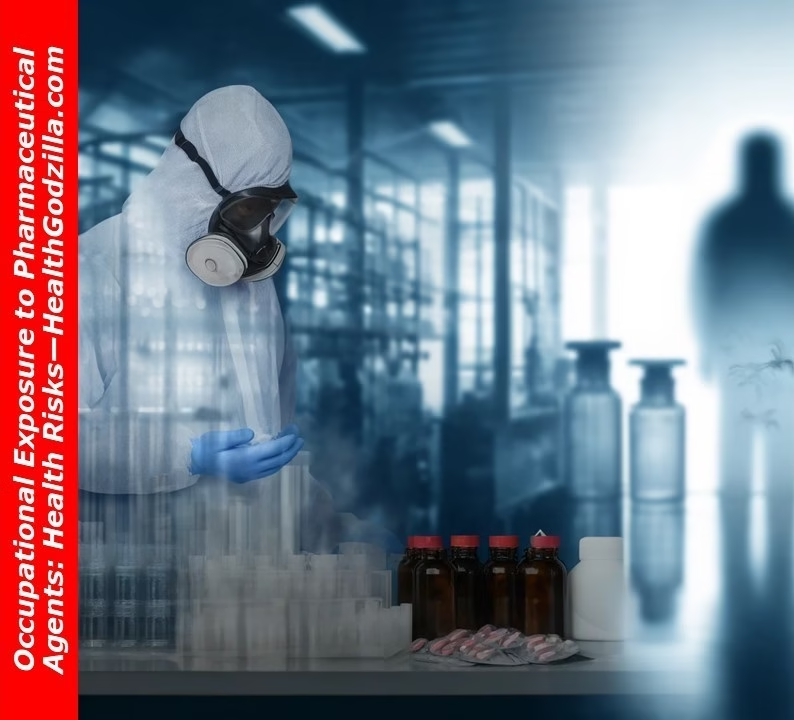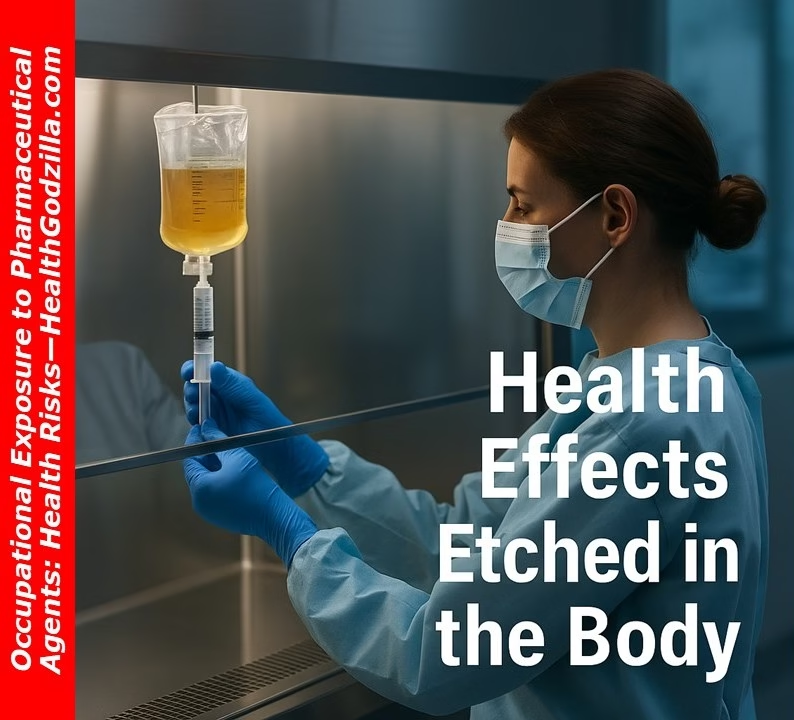
Prologue – Between Cure and Shadow
Every cure carries a shadow. Indeed, in the silent corners of laboratories, in the clatter of hospital corridors, in the long barns of farms—there lies a paradox. Medicines, born to heal, move like double-edged messengers: they bring relief to the sick, yet at the same time their very making can leave unseen marks on those who prepare and deliver them. Ultimately, this is the reality of occupational exposure to pharmaceutical agents—a hidden burden carried quietly by the workers behind the medicine.
Labels do not print this story, and advertisements never whisper it. Rather, it is the story of workers who stand close to remedies in their rawest form, where powders drift, liquids gleam, and the unseen can slip past gloves and masks. Few speak of their risks, few notice their exposures, and therefore the weight of these encounters settles quietly into their bodies.
The International Labour Office has already placed this paradox in its ledger of occupational diseases. However, recognition alone is not protection. Instead, the deeper story lies in shadows carried home on skin, breath, and memory—an unfinished tale, still unfolding.
2. Behind the Medicine: Compounds and Hazards
Step past the silence of the Prologue, and then the shelves reveal themselves. The world of pharmaceutical agents is not one thing but a chorus: synthetic compounds crafted in reactors, molecules coaxed from plants, biologics born of engineered cells. Once again, even animal glands yielded their secrets—hormones taken from living bodies—but eventually the risks of viral and prion disease turned science toward safer designs.
Each compound carries its own signature. Some soothe inflammation, some halt infection, some reshape the rhythms of hormones, and others wage war against cancerous cells. Their purposes are noble, yet nevertheless the very qualities that make them powerful as medicines can turn them into hazards when handled day after day. In truth, this is where occupational exposure to pharmaceutical agents begins: in the everyday contact between compounds and the people who bring them to life.
The International Labour Office has written this truth into its diagnostic and exposure criteria. Therefore, pharmaceutical agents now stand in the formal register of occupational diseases—not as abstractions but as recognized risks to flesh-and-blood workers. It is a quiet acknowledgment that the hands behind the pills and vials are not invisible; they too can suffer.
And who are these hands? They scatter across plants where workers weigh and press powders, hospitals where nurses prepare injections, veterinary clinics where medicines mix into feed, and farms where cattle receive their shots. The circle of exposure is wide, stretching far beyond laboratories. Indeed, every cure we consume has passed through such a circle, and with it, a measure of unseen risk.
3. Invisible Particles, Visible Dangers
The body has many doors, and pharmaceutical agents know how to slip through them. Dust clings to skin, vapors drift into lungs, powders ride beneath fingernails. Inhalation, dermal absorption, accidental ingestion—each route becomes a quiet invitation to substances never meant for the worker’s own healing.
In fact, in production plants, fine particles rise with every weighing, granulation, or milling. Similarly, in hospital wards, a single vial cracked open, a drug reconstituted at a crowded bench, is enough to send invisible threads of medicine swirling into the shared air. These are not the scenes of accidents but rather of ordinary tasks repeated daily. For many workers, this is the frontline of occupational exposure to pharmaceutical agents—not a rare disaster, but a daily presence woven into routine.
A recent multicenter study in Dutch hospitals followed this trail of air. Researchers found that even routine drug reconstitution and handling left inhalable concentrations high enough, at times, to exceed safety thresholds. Consequently, the lesson was stark: exposure is not limited to dramatic spills or carelessness—it lingers in the very atmosphere of work. (Van den Berg et al., 2025)
Air, then, becomes both the carrier of cure and the betrayer of health. What was meant for the bloodstream of patients finds its way into the lungs of those who prepare it. Ultimately, it is an irony written not in headlines but in coughs, rashes, and the slow weight of cumulative dose.
4. When Healing Agents Become Toxic
Some agents are healers only when tightly guided; outside their intended path, they turn merciless. Cytostatic drugs, the weapons of chemotherapy, are crafted to stop the rapid growth of malignant cells. But they are blunt weapons. They cannot distinguish friend from foe. For the nurse preparing an infusion or the worker packaging vials, a trace of powder or a splash on the skin is enough to deliver their mutagenic intent. The risks are not small: damage to DNA, cancers seeded in healthy tissue, reproductive harm that echoes across generations.
Hormonal drugs, too, speak to the body in whispers that can unravel balance. The same compounds that restore cycles or ease the passage of menopause may disturb the endocrine rhythms of those exposed in compounding facilities. Menstrual disorders in women, gynecomastia in men, and disruptions that ripple into fertility—all have been documented when hormones slip into places they do not belong.
Antibiotics, miracle agents against infection, can betray their makers as well. Beta-lactams such as penicillin and cephalosporins are potent allergens. A trace inhaled in a production room, a dusting that clings to fabric, may awaken a sensitization that transforms routine contact into crisis—rashes, wheezing, or the tightening of a throat. For those at the frontline, such reactions are among the clearest signs of occupational exposure to pharmaceutical agents, where medicine becomes a hazard simply by passing through the wrong doorway.
These dangers are not revelations of the present alone. Decades ago, researchers warned of them. Sessink and Bos, in their evaluation of cytostatic drug monitoring, described mutagenic and carcinogenic shadows that could be measured in the very air of pharmaceutical plants. Their call was clear: without vigilance, the medicines of healing would leave scars on those meant to deliver them. (Sessink & Bos, 1999)
The paradox deepens here: the stronger the cure, the sharper the hazard. What heals one body may quietly unravel another.

5. Health Effects Etched in the Body
When pharmaceutical agents drift where they do not belong, they leave more than momentary irritation—they carve legacies into the body.
Cancers stand among the most feared of these legacies. The very drugs designed to kill tumors can also seed malignancy in those who handle them. Breast cancer, leukemia, and respiratory cancers have appeared with troubling frequency in exposed workers, as if the medicine’s original target had been misplaced.
Endocrine disruption tells another story—of hormones that whisper too loudly in bodies unprepared to hear them. Workers exposed to synthetic estrogens or progestogens have reported menstrual irregularities, breast tissue growth in men, and sometimes infertility. The body becomes its own battlefield, rhythms distorted by compounds meant for healing elsewhere.
The liver, too, bears the burden. Metabolizing a constant trickle of foreign agents, it can falter under the strain. Elevated enzyme levels, signs of toxicity, and diseases of the liver have been traced back to long exposure in production lines and laboratories.
Even the breath is not safe. Dusts from antibiotics and enzymes can kindle occupational asthma—wheezing, chest tightness, shortness of breath. Sensitization turns the ordinary act of breathing into a struggle, and once awakened, the body does not easily forget. For many, these conditions are the most visible scars of occupational exposure to pharmaceutical agents, where harm is written into tissue more clearly than words on a page.
A systematic review of biological monitoring makes this truth unavoidable: traces of antineoplastic drugs, the most potent of medicines, have been found in the urine, blood, and breath of workers. These are not abstract risks—they are biomarkers etched into the body itself, proof that exposure seeps past gloves, past protocols, into the intimate chemistry of life. (Leso et al., 2022)
Here lies the quiet evidence: the cure’s shadow carried not just in stories or statistics, but in the living tissue of those who heal others.
6. Case Studies – The Lived Narratives
Numbers can measure risk, but stories show its face. Consider Emily, a quality control technician in a large pharmaceutical plant. Her work was meticulous—testing antibiotic powders, ensuring the drugs met every standard before leaving the factory floor. For years, she trusted her gloves, her mask, the protocols around her.
Yet one day she noticed a rash. Harmless at first, red and itching after a shift. Weeks later, her throat tightened without warning, her breath caught short. The dust she once brushed away had found its way into her body, leaving her sensitized to the very medicines she tested. What began as irritation became asthma, a lifelong companion. It was the human cost of occupational exposure to pharmaceutical agents, carried in her breath and skin rather than in data charts.
Emily’s story is not an isolated one. Research has long shown that antibiotics, especially beta-lactams, can act as potent allergens. Sessink and Bos warned decades ago of mutagenic shadows carried in cytostatic dust. The International Labour Office has placed pharmaceutical agents in its formal recognition of occupational diseases. And systematic reviews—like that of Leso and colleagues—now reveal biological markers of exposure etched in workers’ blood and breath.
A Kenyan study by Gathuru and co-authors traced the same pattern across decades: cancers in workers handling active ingredients, reproductive disorders from hormone exposures, liver toxicity and asthma shadowing those who mixed and packaged drugs.
Emily’s story, then, is not hers alone. It is part of a wider, quiet chorus. Workers in plants, hospitals, and farms—all carry fragments of these risks in their lives. Some are measured in laboratory assays, others in scarred lungs, others in dreams broken by illness.
Behind every tablet swallowed by a patient lies such a story—rarely told, but always present.
7. The Weight of Prevention
If the risks are known, can they be stopped? The answer is neither simple nor uniform. In some hospitals, closed-system devices now shield nurses from chemotherapy vapors; in others, a plastic apron and a hurried mask remain the only line of defense. In some factories, intricate filters draw the air clean; in others, dust still hangs where workers breathe. The unevenness is global, shaped by wealth, oversight, and will.
The International Labour Office calls for protection, reminding industries that they must pair the recognition of pharmaceutical agents as occupational diseases with safeguards. And studies like the Dutch multicenter assessment show that even with protocols, invisible drug particles can hover above reconstitution tables, exceeding safety thresholds and lingering where lungs draw breath. (Van den Berg et al., 2025)
Prevention, then, is heavy work. Gloves, gowns, ventilated cabinets, biological monitoring, careful waste disposal—all these steps exist, yet none erase risk entirely. The weight of occupational exposure to pharmaceutical agents presses on despite them, for the substances are too potent, too fine, too bound to the air and skin.
So the question remains: how much of the shadow do we lift, and how much do we carry? The answer continues to unfold in each ward, each plant, each farm where the work goes on.
8. 🍂 Hello, Artista

“Who heals the healers?” Organum asked, his voice quiet, almost as if speaking to himself. The question floated across the miles, from Boston to Vancouver, like a thin thread of smoke.
Artista laughed softly, though there was a weight behind it. “Maybe no one heals them. Maybe they carry the cure and the wound together, like two sides of a coin.”
“They do,” Organum replied. “Cytostatic drugs that save lives but whisper mutations into the lungs of nurses. Hormones that balance one patient but bend the rhythms of another. Antibiotics that cure infection but awaken asthma in those who prepare them. Every drug is a double-edged blade.”
Artista paused. “And yet, without them, what would we do? Perhaps the blade must be carried, but with care. Gloves, masks, cabinets—armor of a kind. Still, the shadow slips through.”
There was a playful note then, as if she didn’t want to leave the air too heavy. “Whitee and Brownie don’t mind. Rabbits aren’t asked to handle penicillin. Though I still wonder about the hay dust—they sneeze as if conspiring against me.”
Organum chuckled. “My dogs—RD, MD, Barku, and Gulli—are better off. Their medicine is fresh air and stolen bread. But you’re right: even hay, even dust, even air itself carries secrets.”
The line went quiet for a moment, and then Artista said, softly, “So maybe the question isn’t only who heals the healers, but how much risk is acceptable to carry for the sake of healing.”
Neither tried to answer. Some questions, they knew, were meant to linger.
9. ✍️ Author’s Reflection
I did not sit here to write about certainty. If anything, the more I walked with these agents of healing, the more I felt their shadows lengthen. Every vial, every tablet, every powder weighed is a story with two sides—salvation for one, burden for another.
There are measures, yes—gloves, gowns, cabinets, filters—but none of them erase risk, they only shift its weight. I think of workers in far-off factories, nurses bent over infusion bags, farmhands with dust on their sleeves. I think of them breathing, working, carrying fragments of medicines never prescribed to them.
Perhaps this is the true shape of occupational exposure to pharmaceutical agents: not a headline, not a single event, but a quiet layering across time, written into bodies and lives. I cannot tell you where the line of safety ends or where the shadow begins. What I can say is that it exists, and that it matters.
I was not alone when I wrote this. Others spoke, and I listened.
—Jamee
🌼 Articles You May Like
From metal minds to stardust thoughts—more journeys await:
- Groupthink and Leadership: Born or Made in the Mindset Mirror. Groupthink and leadership—twin forces shaped by mindset. Explore how silence, dissent, and growth define whether leaders are born or made.
- Beryllium exposure risks chiefly in high-tech and heavy industries. Covering workplace hazards, chronic disease, global updated guidelines.
- Biodiversity and nutrition: Reforming diets through agrobiodiversity. Policy, Traditional and Indigenous Foods, and Scientific Relevance.
Curated with stardust by Organum & Artista under a sky full of questions.
📚 Principal Sources
- Niu, S., Colosio, C., Carugno, M., & Adisesh, A. (Eds.). (2022). Diagnostic and exposure criteria for occupational diseases: Guidance notes for diagnosis and prevention of the diseases in the ILO list of occupational diseases (Revised 2010). International Labour Office.
- Van den Berg, R. B., Stubbs, P., Boumans-d’Onofrio, J. R. C., Swart, C. W., Steenstra, F. B., Oosterveld, P., Ng, S., Klous, M., Breukels, O., Kuijpers, E., & Crul, M. (2025). Occupational exposure of healthcare workers during drug reconstitution and handling tasks: A multicenter assessment at Dutch hospital wards. Journal of Occupational and Environmental Medicine, 67(7), 571–579.
- Sessink, P. J., & Bos, R. P. (1999). Drugs hazardous to healthcare workers: Evaluation of methods for monitoring occupational exposure to cytostatic drugs. Drug Safety, 20(4), 347–359.
- Leso, V., Sottani, C., Santocono, C., Russo, F., Grignani, E., & Iavicoli, I. (2022). Exposure to antineoplastic drugs in occupational settings: A systematic review of biological monitoring data. International Journal of Environmental Research and Public Health, 19(6), 3737.
Relevant chapters and sections were interpreted through a narrative lens rather than cited academically.
This article is also archived for open access on Zenodo: https://doi.org/10.5281/zenodo.15375617. Archiving ensures its permanence in the scholarly record.

Leave a Reply